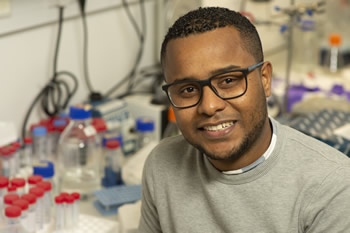Dr. Jailson Brito QueridoBy Dr. Diana Ferro  Dr. Jailson Brito Querido is a postdoctoral scientist in the laboratory of Dr. Venki Ramakrishnan at the MRC Laboratory of Molecular Biology in Cambridge (UK). His research focuses on the role of RNA helicases, such as eIF4A, during translation of mRNA into protein. Dr. Querido started his career at the University of Lisbon in Portugal, where he completed his Bachelor’s and Master degrees. For his Ph.D. with Dr. Yaser Hashem, Dr. Querido went to the University of Strasbourg in France. Dr. Querido’s interest in RNA started during his Ph.D., although it was a shift from his earlier interest. “I was coming from a clinical and immunology lab at the Institute of Hygiene and Tropical Medicine (Portugal),” he said, “and from one day to another, I had to understand structural biology and all this universe of RNA.” His excitement for RNA was inspired in part by a review from Dr. Ramakrishnan (“The Ribosome Emerges from a Black Box”), foreshadowing his choice of postdoctoral advisors. During his Ph.D., Dr. Querido studied translation, and he became “very keen to understand the role of RNA helicases in this process.” But Dr. Querido knew that studying this process would be challenging—” the role of helicases in translation is a tricky problem.” The Ramakrishnan lab has been a pioneer in translation, so Dr. Querido thought this was the right environment to tackle RNA helicases. In fact, Dr. Querido continued, “the LMB is one of the birthplaces of modern molecular biology. This is the kind of place you want to be when you decide to take the risk of working on a difficult problem.” Dr. Querido’s recent work begins to shed light on these mysteries. He has determined a structure of the human 48S translation initiation complex, and his results suggest that the mRNA may be dragged out from the scanning ribosome.
When asked about obstacles of being a scientist, Dr. Querido said that “Moving across countries is, indeed, a common challenge for many scientists, and especially a student might feel fearful of the idea of moving during scientific career. Additionally, by moving to another country for my Ph.D., I also had to overcome the language barrier in my workplace—Portuguese was no longer the language in my workplace. Altogether, at the beginning of my scientific career, this was a big challenge, but for me personally it was also the right thing to do.” Dr. Querido continued, “I have lived in 5 different countries, and I don’t really stay attached to places. Although I would say that people are quite different, what I appreciated in all these countries is that people acknowledge the importance of science.” Those challenges and the enrichment obtained by such an international career contributed effectively to his discoveries and made him a better scientist. Dr. Querido has been inspired by a long list of mentors, and he has been particularly inspired by his scientific heroine Dr. Marie Curie. “If I had to choose one scientist of all times, I would choose Dr. Marie Curie. Not only for her outstanding science, but also for what we can learn from her story. She was a woman in a man’s world, and yet she never felt intimidated to do the best science she could do. I think that the main take-home message from her story is that we should never feel intimidated by being different from the rest of the people in the room, we should just let science guide us and do our best to change the world through science.” Dr. Querido has also been inspired by the science at the RNA Society annual meetings. He said, “the way how cryo-electron microscopy revolutionized our understanding of big RNA-protein complexes, such as ribosomal complexes and spliceosome, was among the most exciting things that I have learned at the RNA Society meetings.” |
